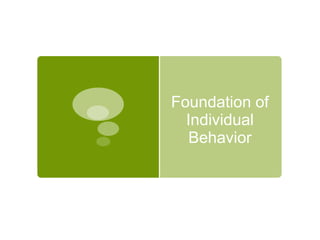
Organizational Behavior
- 1. Foundation of Individual Behavior
- 2. What Is Organizational Behavior? Behavior The actions of people Organizational Behavior The study of the actions of people at work. Attitudes Evaluative statements, either favorable or unfavorable, concerning objects, people, or events
- 3. Employee Productivity Workplace Misbehavior Absenteeism What is the Focus of Job OB? Turnover Satisfaction Organizational Citizenship
- 4. Employee Productivity A performance measure of both work efficiency and effectiveness Absenteeism The failure to show up for work Turnover Voluntary and involuntary permanent withdrawal from an organization
- 5. Organizational Citizenship Behavior Discretionary behavior that’s not part of an employee’s formal job requirements, but which promotes the effective functioning of the organization For Example: performing extra-job activities, helping colleagues. Job Satisfaction An employee’s general attitude toward his or her job, Although job satisfaction is an attitude rather than a behavior, it’s an outcome that concerns many managers
- 6. Workplace Misbehavior Any intentional employee behavior that is potentially harmful to the organization or individuals within the organization For example: playing loud music just to irritate coworkers to verbal aggression to sabotaging work.
- 7. What Do Managers Need to Know About Personality? Personality A unique combination of emotional, thought, and behavioral patterns that affect how a person reacts to situations and interacts with others Myers-Briggs Type Indicator (MBTI) A personality assessment that uses four dichotomies of personality to identify different personality types http://www.humanmetrics.com/cgi-win/jtypes1.htm
- 8. What is The Big Five Model? Big Five Model A personality trait model that examines five traits: 1. Extraversion 2. Agreeableness 3. Conscientiousness, 4. Emotional stability 5. Openness to experience
- 9. WHAT IS EMOTIONAL INTELLIGENCE? Emotional Intelligence (EI) The ability to notice and to manage emotional cues and information
- 10. Five Dimensions of EI Self-awareness Being aware of what you’re feeling. Self-management The ability to manage your own emotions and impulses Self-motivation The ability to persist in the face of setbacks and failures Empathy The ability to sense how others are feeling Social skills The ability to handle the emotions of others
- 11. Can Personality Traits Predict Work-Related Behaviors? Locus of Control The degree to which people believe they control their own fate Self-Esteem (SE) An individual’s degree of like or dislike for himself or herself Self-Monitoring A personality trait that measures the ability to adjust behavior to external situational factors
- 12. What is Perception and What Influences It? Perception A process by which we give meaning to our environment by organizing and interpreting sensory impressions Attribution Theory A theory used to explain how we judge people differently, based on what meaning we attribute to a given behavior
- 14. Can Attributes Be Distorted? Fundamental Attribution Error The tendency to underestimate the influence of external factors and overestimate the influence of internal factors when making judgments about the behavior of others Self-Serving Bias The tendency for individuals to attribute their successes to internal factors while putting the blame for failures on external factors
- 15. Perception Shortcuts Selective Perception The tendency for people to only absorb parts of what they observe, allowing them to “speed read” others Assumed Similarity, or “like me ” effect An observer’s perception of others is influenced more by the observer’s own characteristics than by those of the person observed
- 16. Perception Shortcuts (cont.) Stereotyping When we judge someone on the basis of our perception of a group he or she is part of Halo Effect When we form a general impression of a person on the basis of a single characteristic
- 17. How Does Learning Theory Explain Behavior? Learning A relatively permanent change in behavior that occurs as a result of experience Operant Conditioning A theory of learning that says behavior is a function of its consequences
- 18. What Is Social Learning Theory? Social Learning Theory A theory of learning that says people can learn through observation and direct experience Shaping behavior The process of guiding learning in graduated steps, using reinforcement or lack of reinforcement
- 19. Thank you
